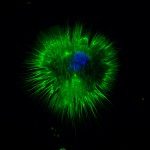Lien vers Pubmed [PMID] – 28745620
J Vis Exp 2017 Jul;(125)
Macrophages are professional phagocytes from the innate arm of the immune system. In steady-state, sessile macrophages are found in adult tissues where they act as front line sentinels of infection and tissue damage. While other immune cells are continuously renewed from hematopoietic stem and progenitor cells (HSPC) located in the bone marrow, a lineage of macrophages, known as resident macrophages, have been shown to be self-maintained in tissues without input from bone marrow HSPCs. This lineage is exemplified by microglia in the brain, Kupffer cells in the liver and Langerhans cells in the epidermis among others. The intestinal and colon lamina propria are the only adult tissues devoid of HSPC-independent resident macrophages. Recent investigations have identified that resident macrophages originate from the extra-embryonic yolk sac hematopoiesis from progenitor(s) distinct from fetal hematopoietic stem cells (HSC). Among yolk sac definitive hematopoiesis, erythromyeloid progenitors (EMP) give rise both to erythroid and myeloid cells, in particular resident macrophages. EMP are only generated within the yolk sac between E8.5 and E10.5 days of development and they migrate to the fetal liver as early as circulation is connected, where they expand and differentiate until at least E16.5. Their progeny includes erythrocytes, macrophages, neutrophils and mast cells but only EMP-derived macrophages persist until adulthood in tissues. The transient nature of EMP emergence and the temporal overlap with HSC generation renders the analysis of these progenitors difficult. We have established a tamoxifen-inducible fate mapping protocol based on expression of the macrophage cytokine receptor Csf1r promoter to characterize EMP and EMP-derived cells in vivo by flow cytometry.
